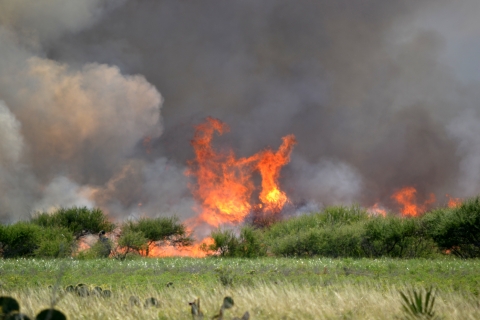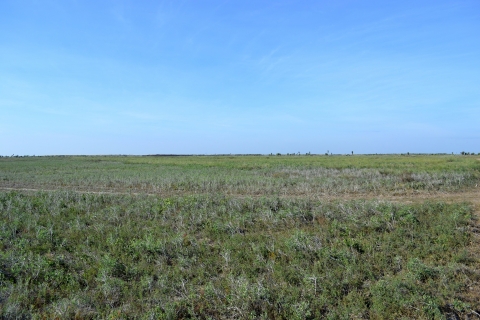Location
States
TexasEcosystem
CoastalIntroduction
The coastal prairie in Laguna Atascosa National Wildlife Refuge-Bahia Grande Unit in South Texas protects inland areas from storm surges and erosion while also serving as habitat for grassland-dependent species, such as the federally Endangered northern aplomado falcon (Falco femoralis septentrionalis). Past research indicates that each falcon breeding pair requires at least two thousand acres of open prairie with low woody plant densities to establish and occupy a territory. Records from the early 1900s indicate the Bahia Grande Unit was once an expansive coastal prairie and home to a healthy northern aplomado falcon population.
However, historic land management practices, such as overgrazing and fire suppression, have resulted in an increase in the density of native woody plant species in the coastal prairie. For example, prior to U.S. Fish and Wildlife Service (USFWS) acquisition in 2000, the area supported private ranching operations during much of the twentieth century. While valuable for thornscrub-dependent species, honey mesquite (Prosopis glandulosa) and huisache (Acacia farnesiana) shrubs are encroaching into the grassland, reducing the cover of gulf cordgrass (Spartina spartinae), a critical component of the northern aplomado falcon’s habitat in the Bahia Grande Unit. Scientists from The Peregrine Fund previously reintroduced the falcons to Coastal Texas. Without these reintroduction efforts, the northern aplomado falcon might have become extinct.
Researchers from the University of Texas at Brownsville (now University of Texas Rio Grande Valley) partnered with The Peregrine Fund and USFWS to evaluate several nature-based strategies for grassland management to address honey mesquite and huisache shrub encroachment in the Bahia Grande coastal prairie. The team measured the effectiveness and financial cost of various combinations of mechanical treatments, herbicide applications, and prescribed fire at reducing cover of woody plants.
Key Issues Addressed
Honey mesquite and huisache shrubs have decreased open prairie area, causing northern aplomado falcons to lose much of their habitat. Shrub encroachment can create habitat for barn (Tyto alba) and great horned (Bubo virginianus) owls. These birds are natural predators of the falcons. Additionally, agricultural activities, including the use of DDT as insecticide, conversion of prairie to cropland, and overgrazing of prairie, contributed to a significant decline in falcon populations. Consequently, the northern aplomado falcon was listed as federally Endangered under the Endangered Species Act in 1986.
Unlike other species of shrubs, honey mesquite and huisache shrubs are able to survive in Bahia Grande’s saline soils. The shrubs’ canopy blocks much of the incoming sunlight from reaching the ground. Lack of light can restrict or eliminate shade-intolerant gulf cordgrass. Reduction of the grass’ fibrous roots destabilizes the soil, increasing the potential for erosion. Woody plants can also decrease soil water content, further stressing gulf cordgrass.
Several treatments, including mechanical mulching, herbicide applications, and prescribed fire, are commonly used in grasslands to manage shrubs. However, managers did not know what combination and timing of treatments would be most effective. Managers needed a strategy that promotes rapid gulf cordgrass recovery and prevents resprouting shrubs in restoration sites.
While woody shrubs threaten falcon habitat, the federally Endangered ocelot (Leopardus pardalis), another priority species for Laguna Atascosa National Wildlife Refuge, utilizes the dense cover provided by native thorny shrubs outside of coastal prairies. To preserve coastal grasslands while also maximizing thornscrub habitat, biologists must implement management actions that balance the needs of multiple wildlife species.
Project Goals
- Determine the effectiveness of eight treatment combinations in reducing honey mesquite and huisache cover
- Remove 99.9% of woody shrubs in the coastal prairie of Bahia Grande, leaving strategically located shrubs to serve as perch habitat for falcons while reducing habitat for owls
- Collaborate with other biologists to identify key management areas for coastal prairie and thornscrub management and restoration to support biodiversity and Endangered species recovery
Project Highlights
- Woody Plant Treatments: Formechanical treatments, an operator used a tractor with a heavy-duty forestry mulcher attachment to remove and shred aboveground woody biomass. Four months following mechanical treatments, crews applied herbicide, a mixture of 20% Remedy Ultra and 80% basal bark oil, to the lowest 18” of shrubs’ bark, especially targeting resprouting shrubs. They conducted fires in accordance with the USFWS’s prescribed fire burn plans.After twelve months, scientists measured shrub abundance, the fraction of dead shrubs left standing, and gulf cordgrass cover to generate a success index value for each combination of mechanical, chemical, and herbicide treatments. Additionally, they determined the cost per acre for each treatment.
- Collaboration and Partnership: The team met with other biologists to survey the Bahia Grande and develop a shared understanding of the impacts of management strategies. The Peregrine Fund contributed historical knowledge and monitoring data of Bahia Grande’s northern aplomado falcon population and provided the herbicide applied during certain treatment regimes. The fire program at Laguna Atascosa National Wildlife Refuge has been integral to the prairie restoration efforts. They incorporate biologists’ management needs when conducting prescribed burns, a nature-based solution, to achieve the desired results.
- Spatial Planning: Biologists and managers meet periodically to determine key management areas for each habitat. They use soil data and GIS software to create maps depicting historical boundaries between prairie and thornscrub. These maps help identify areas where prairie restoration would be most successful while ensuring that historic thornscrub habitats will be preserved. Biologists focus coastal prairie management actions in lower elevation, saline soils that historically supported coastal prairie.
Lessons Learned
The most effective strategy was the most expensive and consisted of mechanical treatment, herbicide application, and prescribed fire. Prescribed fire alone was the cheapest option but was the least effective. Fire does not immediately remove standing shrub structures, and large shrubs are more likely to survive prescribed fire treatments. While fire alone fails to promote rapid gulf cordgrass recovery, it has several benefits when combined with other treatment types. Following a mechanical treatment, prescribed fire cleared debris from the soil and increased recovery rates for gulf cordgrass. However, the use of prescribed fire before herbicide can complicate the herbicide application process—all shrubs appear dead, regardless of whether they survived the fire.
Instead of applying herbicide immediately, managers should wait to observe which shrubs resprout. This waiting period allows more effective and efficient application of follow-up chemical treatments by targeting shrubs that are visibly resprouting. Resprouting occurred more frequently when mechanical treatments were not followed by herbicide application. Because honey mesquite and huisache shrubs resprout easily from remaining root systems, researchers recommend annual herbicide applications for at least two years after mechanical and prescribed fire treatments. Despite initial concerns, invasive grasses and brush did not establish in soils disturbed by mechanical mulching. The naturally saline soils found in the coastal prairie communities of the Bahia Grande Unit likely limited their growth.
Next Steps
- Establish photo monitoring locations at treated sites
- Use a shear-spray technique for shrub treatments: A skid steer with a hydraulic shear cuts the brush and then immediately uses a mounted sprayer to apply herbicide to the stump surface
- Conduct follow-up herbicide applications as needed and implement a prescribed fire regime, preferably every 3-5 years, to maintain coastal prairie grassland
- Coordinate with the refuge’s fire program to determine the best prescribed fire strategy for maintaining coastal prairie after mechanical treatments
- Adjust herbicide mixture based on best available science
Funding Partners
- The Peregrine Fund
- University of Texas - Brownsville
- Laguna Atascosa National Wildlife Refuge
- South Texas Refuge Complex - Fire Program
- USFWS Coastal Program
Resources
- Acharya et al. (2017). “Woody plant encroachment alters soil hydrological properties and reduces downward flux of water in tallgrass prairie.”Plant Soil 414: 379–391.
- Hunt et al. (2013). “Restoring Aplomado Falcons to the United States.” Journal of Raptor Research 47(4): 335-351.
- Verderber, Eric M. (2015). “Restoration strategies to mitigate shrub encroachment into coastal prairies.” University of Texas Rio Grande Valley ScholarWorks - Theses and Dissertations.
- Watson et al. (2018). “Coastal Prairie Recovery in Response to Shrub Removal Method and Degree of Shrub Encroachment.”Rangeland and Ecology Management 72: 275-282.
Contacts
- Jonathan Moczygemba, U.S. Fish and Wildlife Service: jonathan_moczygemba@fws.gov
- Andrew Grunwald, U.S. Fish and Wildlife Service: andrew_grunwald@fws.gov
CART Lead Author
- Jack Carter, CART Student Writer, University of Oklahoma
Suggested Citation
Carter, J., B. (2023). “Coastal Prairie Recovery in Response to Shrub Encroachment.” CART. Retrieved from https://www.fws.gov/project/shrub-control-restore-coastal-prairie.






